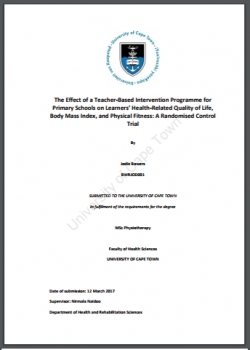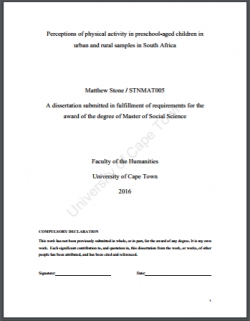The relationship between object control skills, health-related physical fitness and physical activity in 9- to 10-year old girls: the NW-CHILD study

Type
Thesis
Authors
Category
ECCE, Foundation, Intermediate
[ Browse Items ]
Publication Year
2015
Publisher
North West University, Potchefstroom, South Africa
URL
[ private ]
Pages
149 p.
Subject
Early childhood development, Foundation Phase, Intermediate Phase, Object control skills, Health related physical fitness, Physical activity, Girls, North-West Province, South Africa
Tags
Abstract
Several researchers report that object control skills, health-related physical fitness and physical activity are not optimally developed in children. It is also evident from the literature that children, especially girls, are not active enough these days. These trends are disturbing as these are important factors that play a role in the health and sports development later in the child's life. Firstly, this dissertation attempts to examine the relationship between object control skills and health-related physical fitness in nine to ten-year old girls in the North-West Province of South Africa. Secondly, the relationship between object control skills and physical activity levels and patterns in nine to ten-year old girls in the North-West Province of South Africa was investigated. Data were collected by means of a stratified randomised sample of 408 girls with a mean age of 9,86 years (±0,42) who participated in the NW-CHILD study. The Bruininks-Oseretsky Test of Motor Proficiency-2 (BOT-2) (Bruininks & Bruininks, 2005) strength sub-test (standing long jump, push-ups, sit-ups, wall sit and V-up) was used to determine the girls’ strength, the Test of Gross Motor Development-2 (TGMD-2) (Ulrich, 2000) was used to determine the learners’ object control skills and the FITNESSGRAM (Meredith & Welk, 2008) was used to evaluate the girls’ cardiovascular endurance. The Children’s Leisure Activities Study Survey (CLASS) was used to evaluate the physical activity pattern of the girls. Stature, body mass and skinfolds (subscapular, triceps and calf) were measured according to standard kinantropometric protocols. The STATISTICA software package was used to analyse the data. Small but significant correlations were found between object control skills and strength, aerobic fitness and the body composition of the group. According to the healty fitness zone (HFZ) classification, 49.62% (n=198) of girls were categorised as being in the HFZ with regard to their BMI and 54.14% (n=216) in the HFZ with regards to the FAT%. This indicates that object control skills are influenced by factors that can contribute to the health of young girls. Participation in physical activities should therefore be increased. Appropriate development of object control skills (OC) and strength skills in girls is recommended to prevent delays in sports participation. Further investigation involved racial differences in activity performances. Ninety white and 318 black girls with a mean age of 9.86 years participated in this study. OC skills were assessed. Statistically (p≤0.001) and practically significant differences between the white and black girls were found, where the white girls participated more in ten of the moderate intensity physical activities than the black girls and the black girls participated more in three of these activities. Activities in which white girls mostly participated contributed significantly to higher moderate to high intensity.
Number of Copies
1
| Library | Accession No | Call No | Copy No | Edition | Location | Availability |
|---|---|---|---|---|---|---|
| 1 | Potchefstroom, North West Province, South Africa | Yes |


